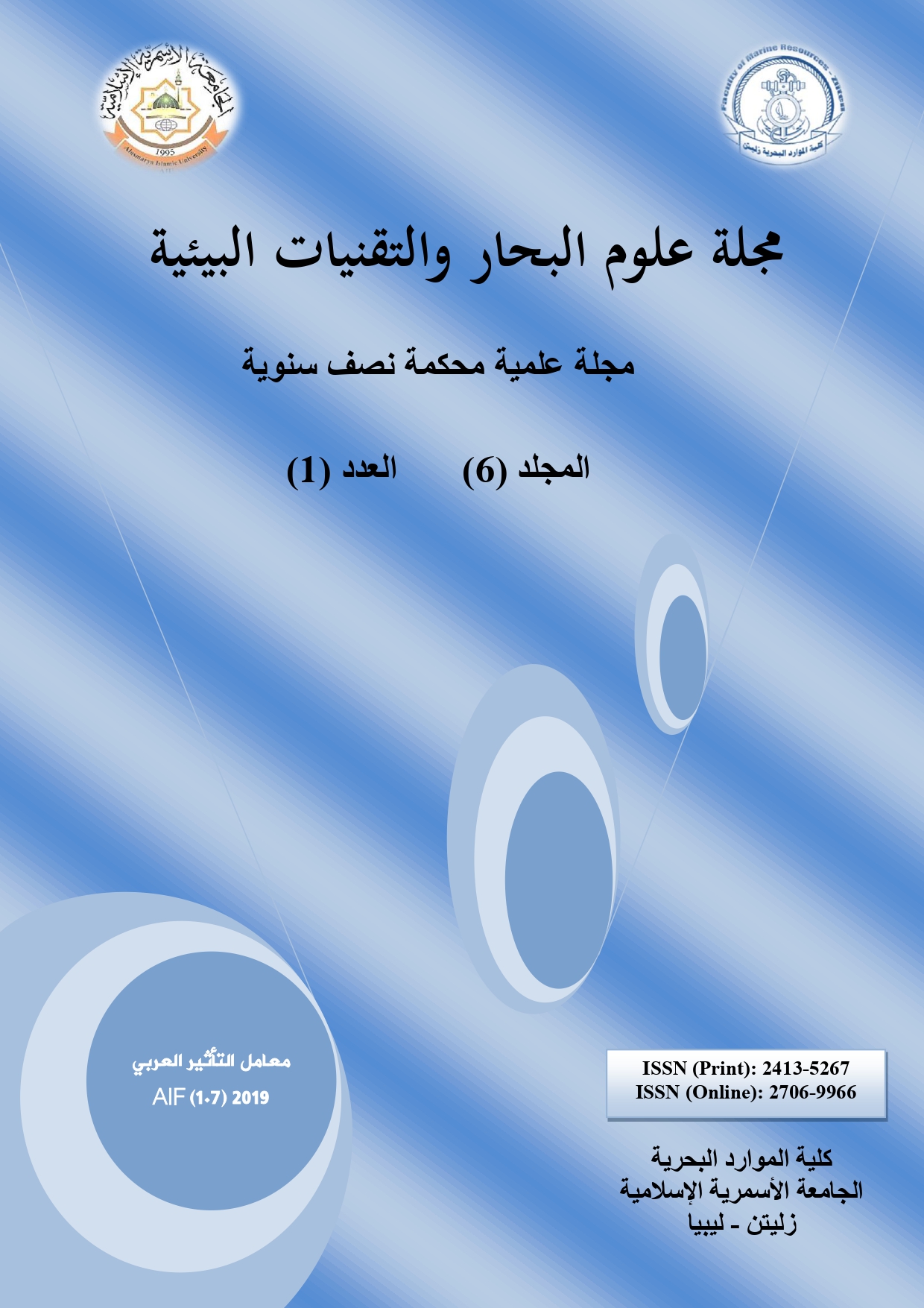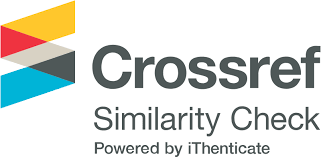تقييم تأثير بعض المستخلصات النباتية على البكتيريا المعزولة من بيئة المطابخ
DOI:
https://doi.org/10.59743/jmset.v6i1.53الكلمات المفتاحية:
التلوث، المطابخ، Lactococcus، Micrococcus، Staphylococcusالملخص
تعتبر النباتات الراقية مصدراً للمنتجات الطبيعية المضادة للميكروبات، تتواجد الميكروبات في بيئات مختلفة منها البيئات الداخلية للمنازل بما في ذلك المطابخ، لذا هدفت هذه الدراسة إلى التخلص من التلوث الميكروبي في المطابخ باستخدام المستخلصات المائية للقرنفل والريحان والكافور وعصير الليمون ومقارنة كفاءتها بالمنظفات الكيميائية من الكلوروكس والكلور والخل وسائل غسل الاواني. أظهرت نتائج هذه الدراسة أن جميع عينات البكتيريا المعزولة من المطابخ موجبة لصبغة الجرام تتمثل في بكتيريا Staphylococcus وMicrococcus وLactococcus، ووجد أن أكثر المستخلصات النباتية تأثيرا عليها هو عصير الليمون، الذي وجد أكثر كفاءة من القرنفل بمقدار الضعف لقطر منطقة التثبيط على بكتيريا Staphylococcus وبمقدار 69% على بكتيريا Lactococcus في التراكيز الأصلية. كذلك ظهر من خلال النتائج أن أكثر المنظفات كفاءة سائل غسيل الأواني بنسبة 42% أعلى من الكلور في منع نمو بكتيريا Lactococcus، وبنسبة 70% من الكلور و55% من الخل في منع نمو بكتيريا Micrococcus في التراكيز الأصلية، بينما تفوق الخل في منع نمو بكتيريا Staphylococcus بقطر منطقة تثبيط اعلى من سائل غسيل الأواني بنسبة 23% والكلور بنسبة 17%. ولم تؤثر المستخلصات النباتية للكافور والريحان ومنظف الكلوروكس بجميع التراكيز على البكتيريا قيد الدراسة، وكانت بكتيريا Micrococcus أكثر مقاومة للمستخلصات النباتية وأكثر تأثرا بالمنظفات الكيميائية.
التنزيلات
المراجع
قائمة المراجع باللغة العربية:
بدر الدين، رضوان؛ العقلة، بسام؛ الأمير، لينة (2013). دراسة التركيب الكيميائي والتضاد البكتيري للزيوت العطرية المستخلصة من قشور ثمار الحمضيات. مجلة جامعة دمشق للعلوم الأساسية، 29(2): 83–100.
حماد، لهيب رجب (2014). دراسة تأثير بعض المستخلصات النباتية على نمو بكتريا الزوائف الزنجارية (Pseudomonas aeruginosa) المرضية والرمية )البرية( وعلى إنتاجها لصبغة البايوسيانين. مجلة الأنبار للعلوم البيطرية، 7(1): 26-32.
خضير، عدي سليمان؛ فارس، جواد كاظم؛ مدب، محمد معروف (2016). تأثير استعمال زيت نبات القرنفل(Syzygiumaromaticum) في بعض الصفات الفسلجية وصورة الدم في الأرانب المحلية. مجلة جامعة بابل العلوم الصرفية والتطبيقية، 24(8): 2198–2208.
عبود، حسين عبد الرزاق؛ بندر، خليل ابراهيم؛ زين العابدين، صلاح سلمان (2107). تأثير دقائق الفضة النانوية المحضرة باستخدام أنواع من الستربتومايسس على بعض البكتيريا المرضية. مجلة تكريت للعلوم الصرفة، 22(3): 17–26.
قائمة المراجع باللغة الإنجليزية:
Adedeji G.B., Fagade O.E., and Oyelade A.A. (2007). Prevalence of Pseudomonas aeruginosa in Clinical Samples and its Sensitivity to Citrus Extract. African Journal of Biomedical Research, 10 (2): 183-187.
Agatemor C. (2009). Antimicrobial activity of aqueous and ethanol extracts of nine Nigerian spices against four food borne bacteria. Internet Journal of Food Safety, 10: 77–80.
Al-Maeeny S.A., Al-Thawani A.N., and Alazawi A.H. (2007). Evaluation of Inhibition Activity of Ocimum Basilicum Leaves Extracts on Some Pathogenic Microorganisms. Iraqi J. Biotech., 6(2): 100-109.
Bhowmik T., and Marth E.H. (1990). Rote of Micrococcus and Pediococcus Species in Cheese Ripening: A Review. Journal of Dairy Science, 73(4): 859-866.
Brown A.E. (2007). Benson`s Microbiological Applications Laboratory Manual in General Microbiology, 10th ed., McGraw-Hill Inc., USA.
Casalta E., and Montel M.C. (2008). Safety assessment of dairy microorganisms: the Lactococcus genus. International Journal of food microbiology, 126(3): 271-273.
Cermelli C., Fabio A., Fabio G., and Quaglio P. (2008). Effect of Eucalyptus Essential Oil on Respiratory Bacteria and Viruses. Current Microbiology, 56(1): 89–92.
Clinical and Laboratory Standard Institute (CLSI) (2013). Performance standards for antimicrobial susceptibility testing. Twenty- third Informational Supplement., CLSI document M100-S22. Wayne. PA.
Cowan M.M. (1999). Plant products as antimicrobial agents. Journal of Clinical Microbiology Reviews, 12 (4): 564-582.
Dhanavade M.J., Jalkute C.B., Ghosh J.S., and Sonawane K.D. (2011). Study Antimicrobial Activity of Lemon (Citrus lemon L.) Peel Extract. British Journal of Pharmacology and Toxicology, 2(3): 119-122.
Evans E.W., and Redmond E.C. (2018). Behavioral Observation and Microbiological Analysis of Older Adult Consumers' Cross-Contamination Practices in a Model Domestic Kitchen. Journal of Food Protection, 81(4): 569–581.
George F.O.A., Ephraim R.N., Obasa S.O., and Bankole M.O. (2009). Antimicrobial properties of some plant extracts on organisms associated with fish spoilage. 1st African organic conference, Sheraton Hotel, Kampala.
Hayashi H., Iizuka M., Katsuta T., Shimada T., and Mishima A. (2007). Effects of Tea and Fruits Juice on Bacterial Proliferation. Journal of Chugokugakuen, 6: 5-10.
Jayana B.L., Prasai T., Singh A., and Yami K.D. (2010). Study of Antimicrobial Activity of Lime Juice against Vibrio Cholerae. Journal of Scientific World, 8(8): 144-147.
Kloos W.E., and Musselwhite M.S. (1975). Distribution and persistence of Staphylococcus and Micrococcus species and other aerobic bacteria on human skin. Applied microbiology, 30(3): 381-395.
Kwon J., Wilson A.N., Bednar C., and Kennon L. (2008). Food Safety Knowledge and Behaviors of Women, Infant, and Children (WIC) Program Participants in the United States. Journal of Food Protection, 71(8): 1651–1658.
Lee O.G., Choi G.J., Jang K.S., Lim H.K., Cho K.Y., and Kim J.C. (2007). Antifungal activity of five plant essential oils as fumigant against postharvest and soil borne plant pathogenic fungi. Plant Pathol. J., 23: 97–102.
Lee J.H. (2018). An Investigation of Factors that Influence Hygiene Practices at a Small Day Care Center. Journal of Food Protection, 81(1): 158–164.
Le Loir Y., Baron F., and Gautier M. (2003). Staphylococcus aureus and food poisoning. Genet Mol Res, 2(1): 63-76.
Lina G., Piémont Y., Godail-Gamot F., Bes M., Peter M.O., Gauduchon V., Vandenesch F., and Etienne J. (1999). Involvement of Panton-Valentine leukocidin—producing Staphylococcus aureus in primary skin infections and pneumonia. Clinical Infectious Diseases, 29(5): 1128-1132.
Lowy F.D. (1998). Staphylococcus aureus infections. New England journal of medicine, 339(8): 520-532.
Luber P., Brynestad S., Topsch D., Scherer K., and Bartelt E. (2006). Quantification of Campylobacter Species Cross-Contamination during Handling of Contaminated Fresh Chicken Parts in Kitchens. Applied and Environmental Microbiology, 72(1): 66–70.
Cheesbrough M. (2006). District laboratory practice in tropical countries, part 2. Cambridge university press.
Najim S.S. (2017). The Efficiency of Dettol as Detergent against Microbial Biofilm formation isolated from UTI infections. Current Research in Microbiology and Biotechnology, 5(6): 1380-1384.
Negi P.S. (2012). Plant extracts for the control of bacterial growth: Efficacy, stability and safety issues for food application. International Journal of Food Microbiology, 156(1): 7–17.
Ogston A. (1882). Micrococcus poisoning. Journal of anatomy and physiology, 16(4): 526.
Park D., Bitton G., and Melker R. (2006). Microbial inactivation by microwave radiation in the home environment. Journal of Environmental Health, 69(5): 17.
Russell A.D., and Day M.J. (1996). Antibiotic and biocide resistance in bacteria. Microbios, 85(342): 45-65.
Shittu I.A.J., Bankole M.A., Ahmed T., Bankole M.N., Shittu R.K., Saalu C.L., and Ashiru O.A. (2007). Antibacterial and antifungal activities of essential oils of crude extracts of Sesamum radiatum against some common pathogenic microorganisms. Iranian Journal of Pharmacology and Therapeutics (IJPT), 6: 165-170.
Sherry E., Boeck H., and Warnke P.H. (2001). Topical application of a new formulation of eucalyptus oil phytochemical clears methicillin-resistant Staphylococcus aureus infection. Am. J. Infect. Control, 29(5): 346.
Speirs J.P., Anderton A., and Anderson J.G. (1995). A study of the microbial content of the domestic kitchen. Journal of Environmental Health Research, 5(2): 109-122.
Tebbutt G.M. (1986). An evaluation of various working practices in shops selling raw and cooked meats. Epidemiology & Infection, 97(1): 81-90.
Trivedi N.A., and Hotchandani S.C. (2004). A study of the antimicrobial activity of oil of Eucalyptus. Indian J. Pharmacol., 36: 93–94.
Vandepitte J., Engback K., Piot P., and Iteuk C.C. (1991). Basic laboratory procedures in clinical bacteriology. World Health Organization.
Zhao P., Zhao T., Doyle M.P., Rubino J.R., and Meng J. (1998). Development of a Model for Evaluation of Microbial Cross-Contamination in the Kitchen. Journal of Food Protection, 61(8): 960-963.
التنزيلات
منشور
إصدار
القسم
الرخصة
الحقوق الفكرية (c) 2020 مجلة علوم البحار والتقنيات البيئية

هذا العمل مرخص بموجب Creative Commons Attribution 4.0 International License.












